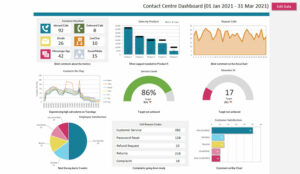Customer experience (CX) currently takes centre stage, with 77% of customers emphasizing its importance alongside product and price.
Quality assurance is vital for customer satisfaction, making a robust call centre agent performance scorecard crucial.
To prioritize exceptional customer service, call centres need an effective mechanism for supervising, measuring, monitoring, mentoring, and continuously improving agent performance.
A well-constructed scorecard serves as a meaningful tool for agents, a valuable asset for management, and, most importantly, beneficial for customers.
Call centre QA monitoring scorecards offer an ideal dashboard of metrics to track, train, and develop the assets directly responsible for customer experience. They also provide valuable data for understanding the root causes of poor service.
Building a Call Centre Quality Assurance Scorecard is manageable, utilizing existing components with a focus on organization and deliverables.
In this blog, we will take you through a step-by-step process for creating a tailored scorecard to meet your organization’s needs.
What is a Contact Centre Scorecard?
A Contact Centre Scorecard is a detailed analysis of call centre agent performance, evaluating the initial interaction between a company and its customers.
It assesses agent performance, customer feedback, and communication preferences to ensure compliance with internal business standards.
The scorecard’s importance lies not only in evaluating individual agent performance but also in identifying broader trends.
Using templates like an Excel-based scorecard, companies track metrics such as Average Handling Time (AHT) to gauge call efficiency.
Regular updates to the scorecard, facilitated by automation tools, are essential for staying relevant and fostering continuous improvement.
Reviews based on in-house policies become catalysts for enhancing agent productivity and overall customer service.
What is the Purpose of a Contact Centre Scorecard?
Call centre agent scorecards offer various benefits to maximize the efficiency and effectiveness of contact centre operations. Key reasons for using these scorecards include:
1. Performance Evaluation
Call quality scorecards assist supervisors and managers in making well-informed decisions regarding promotions, bonuses, and other performance-related matters.
2. Quality Assurance
QA Scorecards play a major role in monitoring and measuring the quality of interactions between agents and customers.
They guarantee compliance with standards and elevate service quality levels, centralizing quality assurance efforts within the contact centre.
3. Agent Training and Development
The contact centre evaluation form offers actionable insights into agent strengths and weaknesses, serving as a foundation for targeted training programs.
4. Customer Experience Improvement
Scorecards often include components related to customer interactions, such as call quality, resolution time, and customer satisfaction.
By monitoring these aspects, contact centres can identify areas for improvement to enhance the overall customer experience.
5. Operational Efficiency
QA Scorecards boost operational efficiency by identifying inefficiencies in agent performance, streamlining processes, and optimizing resource allocation.
They offer a standardized method for measuring and managing agent performance, enhancing evaluation processes.
6. Data-Driven Decision Making
Scorecards serve as a robust source of data, empowering managers to make informed decisions by identifying and analyzing trends and patterns in agent performance.
This shift towards data-driven decision-making ensures that managerial actions are grounded in tangible data rather than subjective opinions.
7. Risk Mitigation and Compliance
Call quality scorecards can include components related to regulatory compliance and adherence to scripts and guidelines.
This helps ensure that agents are following legal and procedural requirements, reducing the risk of compliance issues.
How to Create a Scorecard in 5 Steps?
Step 1: Define Your Objectives
While call centres share common features, each is unique, necessitating specific measurements.
Clearly outline your goals, whether they involve enhancing customer satisfaction, improving efficiency, or achieving first-call resolution.
Determine the primary objective of your contact center, like fostering a positive customer experience, and use this focus to guide scorecard development.
Ask critical questions to refine your objectives, such as:
- What are we hoping to achieve with the scorecard?
- What weaknesses in the call centre should we target?
- Is there a need to change the way we train our agents?
Step 2: Determine Relevant Metrics
After defining your objectives, the next step is to identify Key Performance Indicators (KPIs) that align with your goals.
For instance, if your primary goal is customer satisfaction (CSAT), focus on metrics that directly reflect the satisfaction level of customers with your support team and interactions.
These metrics may include customer satisfaction scores, average handling time, first-call resolution, agent productivity, and other factors critical to your contact centre’s success.
Ensure that your scorecard metrics are in line with company goals and objectives, shaping them to align with broader company targets.
Step 3: Set Performance Targets
Establish realistic and measurable performance targets for each metric. Setting targets provides a benchmark for success and helps track progress toward your objectives. Ensure that these targets are aligned with overall business goals and industry standards.
For instance, if one of your identified metrics is customer satisfaction (CSAT), set a performance target aiming for a specific CSAT score, providing a tangible goal for your team to work towards and a clear measure of success in meeting customer satisfaction objectives.
Step 4: Choose a Contact Centre Scorecard Software
Many call centres currently use Excel spreadsheets for scorecard data collection, but a more advanced and efficient approach involves utilizing Contact Centre Software equipped with specialized feedback and scoring features.
Integrated platforms capable of creating call quality scorecards and overseeing entire call centre workforces from a unified interface eliminate the need for redundant tools. Choosing the appropriate software for scorecard implementation is crucial.
Pro Tip: Seek tools that offer easy customization, real-time data tracking, and extensive reporting capabilities. The selected software should be adaptable to evolving needs and provide a user-friendly interface for both monitoring and analysis.
Step 5: Implement Continuous Monitoring and Improvement
The presentation of data is crucial for helping managers identify call centre strengths and weaknesses, enabling targeted agent coaching.
It’s equally important to make this data accessible to agents in a way that encourages self-monitoring, such as creating mental maps linking actions to specific Key Performance Indicators (KPIs).
Continuously monitor and update scorecards to maintain relevance. Establish a system for ongoing monitoring, analyzing performance data, identifying trends, and making data-driven decisions.
Implement feedback loops and training programs to address performance gaps, ensuring continuous optimization of contact centre operations.
Elevate Contact Centre Performance Through Scorecards
Call centre agent scorecards optimize outbound sales by ensuring agents meet desired contact centre metrics and goals.
These scorecards empower organizations to enhance sales and support effectiveness, improve customer interactions, and drive revenue growth.
Utilizing scorecards to focus on operational efficiency and pinpoint areas for improvement, facilitates call centres to achieve maximum performance and success.
Strategic scorecard implementation establishes a foundation for data-driven excellence, driving continuous improvement and informing decisions.
Leveraging insights through software adaptation enables organizations to deliver exceptional customer experiences, foster loyalty, and stay ahead.
Data-driven decisions elevate contact centre performance, ensuring sustained success and growth.
This blog post has been re-published by kind permission of Five9 – View the Original Article
For more information about Five9 - visit the Five9 Website
Call Centre Helper is not responsible for the content of these guest blog posts. The opinions expressed in this article are those of the author, and do not necessarily reflect those of Call Centre Helper.
Author: Five9
Published On: 12th Jan 2024 - Last modified: 9th Dec 2024
Read more about - Guest Blogs, Five9






 Five9 empowers organizations to create hyper-personalized and effortless AI-driven customer experiences that deliver better business outcomes. Powered by Five9 Genius AI and our people, the Five9 Intelligent CX Platform is trusted by 3,000+ customers and 1,400+ partners globally. The New CX starts here and it's at the heart of every winning experience.
Five9 empowers organizations to create hyper-personalized and effortless AI-driven customer experiences that deliver better business outcomes. Powered by Five9 Genius AI and our people, the Five9 Intelligent CX Platform is trusted by 3,000+ customers and 1,400+ partners globally. The New CX starts here and it's at the heart of every winning experience. 






























